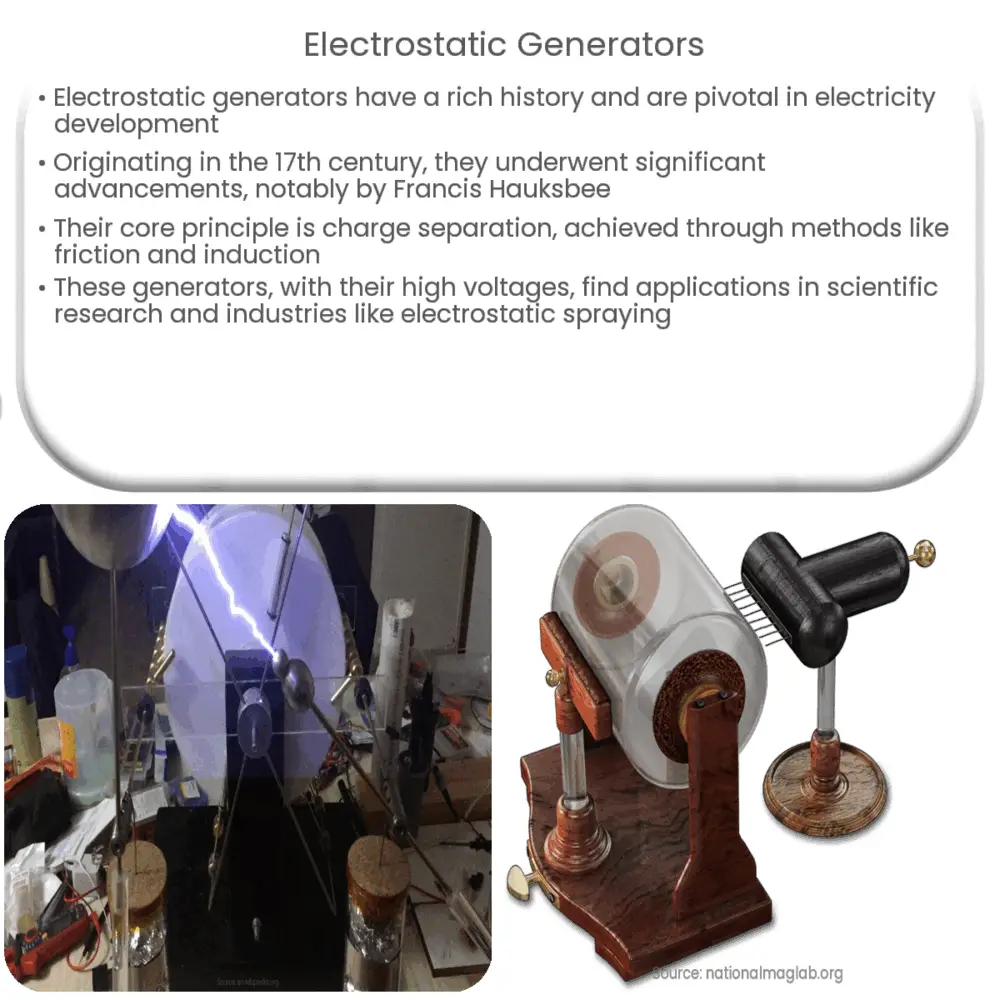An error occurred. Either the engine you requested does not exist or there was another issue processing your request. If this issue persists please contact us through our help center at help.openai.com.

Introduction to Electrostatic Generators
Electrostatic generators are fascinating machines with a rich history, providing a captivating glimpse into the development of electricity as we know it today. They operate on principles of static electricity and electrostatic induction, creating high voltages that have been instrumental in numerous scientific experiments.
Origins and Evolution
The inception of the electrostatic generator can be traced back to the 17th century. Otto von Guericke, a German scientist and mayor of Magdeburg, was among the first to develop a basic model. His invention, known as the Magdeburg hemispheres, consisted of two large hemispherical shells that were pumped free of air. This represented a significant contribution to the understanding of atmospheric pressure and vacuum.
From Guericke’s basic model, the electrostatic generator evolved over centuries. The most notable advancement was made by the Swiss scientist, Francis Hauksbee, in the early 18th century. He improved upon Guericke’s design by inventing the glass globe generator, a forerunner of modern electrostatic generators.
Working Principle
At its core, the electrostatic generator operates on the principle of charge separation. Essentially, two materials are rubbed together, leading to a transfer of electrons, and thus, creating an imbalance of charge. This imbalance is responsible for the generation of static electricity.
- Friction: The friction method involves rubbing two different materials together. One material loses electrons and becomes positively charged, while the other gains electrons and becomes negatively charged.
- Induction: Induction, another key process, doesn’t involve direct contact. Instead, a charged object is brought near a neutral object, causing the neutral object’s charges to separate.
- Conduction: Finally, the principle of conduction occurs when a charged object touches a neutral object. The electrons move from the charged object to the neutral one, causing the latter to gain a net charge.
This transfer of electrons and the subsequent separation of charge is the fundamental basis of an electrostatic generator. The larger the charge separation, the higher the voltage, which can reach up to hundreds of thousands, or even millions, of volts[1].
Types of Electrostatic Generators
As technology advanced, several variations of electrostatic generators were developed, each differing in construction and method of operation.
- Wimshurst Machine: This is an electrostatic generator which uses two large contra-rotating disks to generate an electrostatic charge, which is then stored in Leyden jars. It was invented by British inventor James Wimshurst around 1880.
- Van de Graaff Generator: This is a type of electrostatic generator that was invented by the American physicist Robert J. Van de Graaff in the 1930s. The generator works by transferring charge to a large hollow spherical electrode, usually via a moving belt.
- Pelletron: This is a modern type of electrostatic generator used in particle accelerators. It uses a chain with alternating insulating and conducting links to transport charge. The Pelletron was first developed in the 1970s and is a modification of the Van de Graaff generator.
Applications
The high voltage produced by electrostatic generators has a wide range of applications. They are used in scientific research, particularly in physics experiments. For instance, particle accelerators use electrostatic generators to accelerate ions to high speeds for research purposes. In addition, these generators are used in industry for applications like electrostatic spraying and electrostatic precipitation.
Conclusion
In conclusion, electrostatic generators are incredible machines that have played a vital role in the development of our understanding of electricity. They are based on the principle of charge separation and generate high voltages. Despite their long history, these generators continue to be used today in various fields including scientific research and industrial applications. Their simplicity, versatility, and reliability make them a timeless tool in the realm of electricity and magnetism.

